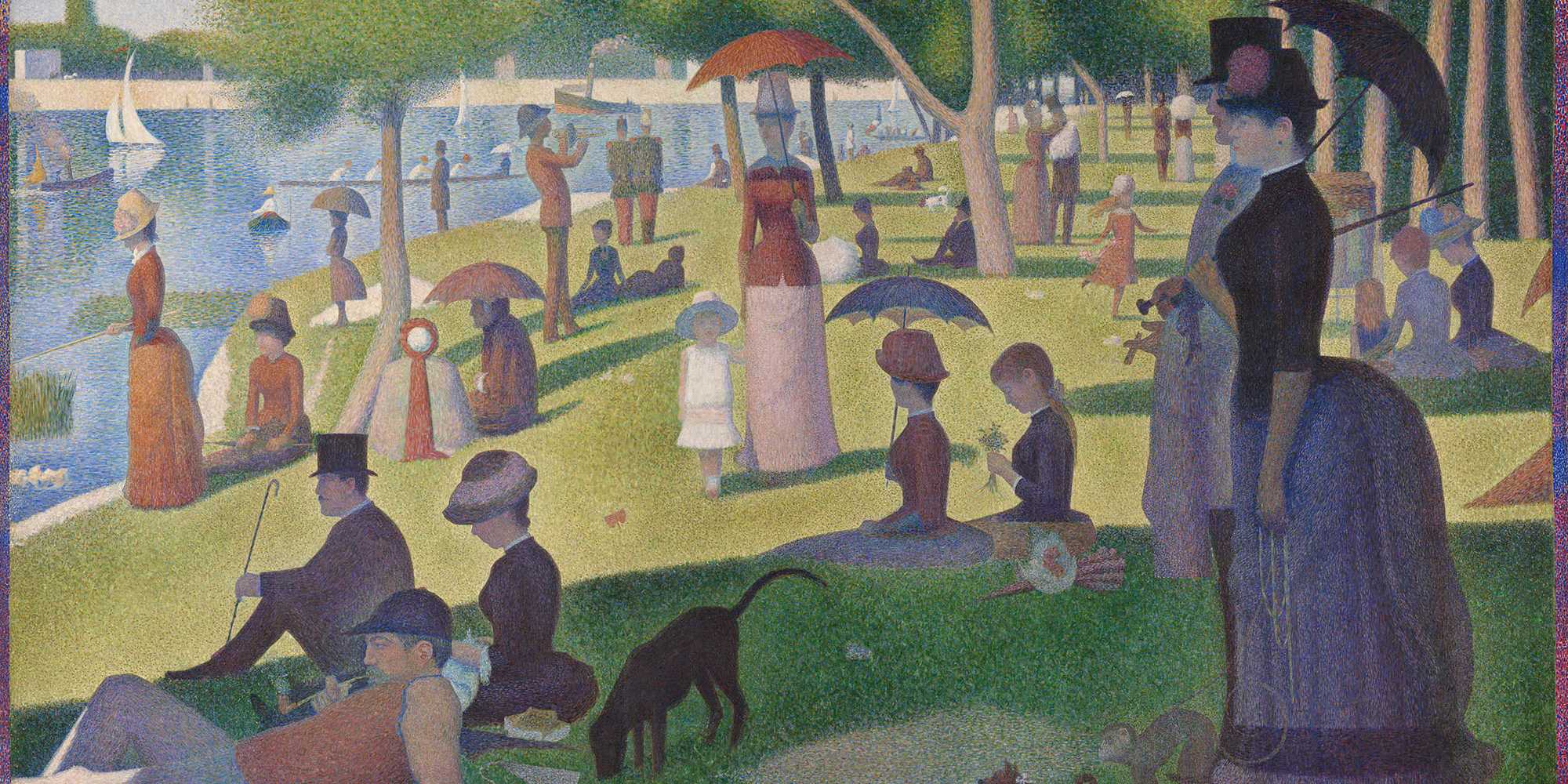By analysing images made of coloured dots created by quantum simulators, ETH researchers have studied a special kind of magnetism. In the future this method could also be used to solve other physics puzzles, for instance in superconductivity.

In brief
- Researchers at ETH have studied in detail how single moving electrons can cause a material to become magnetic.
- Using quantum simulators, researchers in the U.S. have created images made of coloured dots which they were able to interpret thanks to the new method ("quantum pointillism") of the ETH researchers.
- This method might allow physicists to solve other tricky physics problems in the future.
Up close it looks like lots of coloured dots, but from a distance one sees a complex picture rich in detail: Using the technique of pointillism, in 1886 George Seurat created the masterpiece „A Sunday afternoon on the island of La Grande Jatte". In a similar way, Eugene Demler and his coworkers at ETH Zurich study complex quantum systems made of many interacting particles. In their case, the dots are not created by dabbing a paintbrush, but rather by making individual atoms visible in the laboratory.
Together with colleagues in Harvard and Princeton, Demler's group has now used the new method - which they call "quantum pointillism" - to take a closer look at a special kind of magnetism. The researchers have just published their results in two papers in the scientific journal Nature.
Paradigm shift in understanding
"These studies represent a paradigm shift in our understanding of such magnetic quantum phenomena. Until now, we were not able to study them in detail", says Demler. It all started around two years ago at ETH. The group of Ataç Imamoğlu experimentally investigated special materials with a triangular crystal lattice (moiré materials made of transition metal dichalcogenides). When Demler and his postdoc Ivan Morera analysed Imamoğlu's data, they encountered a peculiarity that suggested a kind of magnetism that had previously only been predicted theoretically. "In this kinetic magnetism, a few electrons moving inside the crystal lattice can magnetise the material", Morera explains.

In Imamoğlu's experiment this effect, known as Nagaoka mechanism among experts, could be detected for the first time in a solid by measuring, amongst other things, the magnetic susceptibility - that is, how strongly the material reacts to an external magnetic field. "That detection was based on very strong evidence. For a direct proof, however, one would have to measure the state of the electrons - their position and spin direction - simultaneously in several places inside the material", says Demler.
Complex processes made visible
In a solid, however, this is not possible with conventional methods. At most, researchers can use X-ray or neutron diffraction to find out how the spins of the electrons relate to each other at two positions - the so-called spin correlation. Correlations between complex spin arrangements and additional or missing electrons cannot be measured in this way.
To still make the complex processes of the Nagaoka mechanism visible, which Demler and Morera had calculated using a model, they turned to colleagues in Harvard and Princeton. There, research teams led by Markus Greiner and Waseem Bakr have developed quantum simulators that can be used to precisely recreate the conditions inside a solid. Instead of electrons moving inside a lattice made of atoms, in such simulators the U.S. researchers use extremely cold atoms trapped inside an optical lattice made of light beams. The mathematical equations describing the electrons inside the solid and the atoms inside the optical lattice, however, are almost identical.

Coloured snapshots of the quantum system
Using a strongly magnifying microscope, Greiner's and Bakr's groups were able not only to resolve the positions of the individual atoms, but also their spin directions. They translated the information obtained from these snapshots of the quantum system into coloured graphics that could be compared to the theoretical pointillist pictures. Demler and his coworkers had theoretically calculated, for instance, how a single extra electron in the Nagaoka mechanism forms a pair with another electron of opposite spin and then moves through the triangular lattice of the material as a doublon. According to the prediction of Demler and Morera, that doublon should be surrounded by a cloud of electrons whose spin directions are parallel, or ferromagnetic. Such a cloud is also known as a magnetic polaron.
That is exactly what the American researchers saw in their experiments. Moreover, if there was an atom missing in the crystal optical lattice of the quantum simulator - which corresponds to a missing electron or "hole" in the real crystal - then the cloud forming around that hole consisted of pairs of atoms whose spins pointed in opposite directions, just as Demler and Morera had predicted. This antiferromagnetic order (or, more precisely: antiferromagnetic correlations) had also previously been indirectly detected in a solid state experiment at Cornell University in the U.S. In the quantum simulator, it now became directly visible.
"For the first time, we have solved a physics puzzle using experiment both on the 'real' solid as well as in the quantum simulator. Our theoretical work is the glue that holds everything together", says Demler. He is confident that in the future his method will also be useful for solving other tricky problems. For instance, the mechanism that causes the magnetic polaron cloud to form could also play an important role in high temperature superconductors.
Reference
Martin Lebrat, Muqing Xu, Lev Haldar Kendrick, Anant Kale, Youqi Gang, Pranav Seetharaman, Ivan Morera, Ehsan Khatami, Eugene Demler, Markus Greiner. Observation of Nagaoka polarons in a Fermi-Hubbard quantum simulator. Nature, 9 May 2024, DOI: external page10.1038/s41586-024-07272-9
Max L. Prichard, Benjamin M. Spar, Ivan Morera, Eugene Demler, Zoe Z. Yan, Waseem S. Bakr. Directly imaging spin polarons in a kinetically frustrated Hubbard system. Nature, 9 May 2024, DOI: external page10.1038/s41586-024-07356-6






